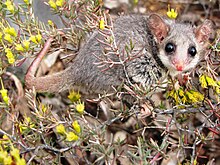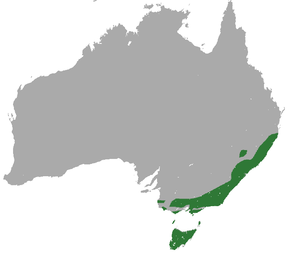Thick-tailed sleeper
| Thick-tailed sleeper | ||||||||||||
|---|---|---|---|---|---|---|---|---|---|---|---|---|

Thick-tailed sleeping bag ( Cercartetus nanus ) |
||||||||||||
| Systematics | ||||||||||||
|
||||||||||||
| Scientific name | ||||||||||||
| Cercartetus nanus | ||||||||||||
| ( Desmarest , 1818) |
The thick-tailed sleeping bag ( Cercartetus nanus ) belongs to the Diprotodontia , an order from the subclass of the marsupials. It occurs from southern Queensland to eastern South Australia and in Tasmania . It has been found in habitats such as rainforests , hardwood forests , wooded areas, and heathlands .
description
The thick-tailed sleeping bag is very small, weighing 15 to 43 grams, a body length of 7 to 9 centimeters and a tail length of 8 to 11 centimeters. Its fur is gray on the back and white on the belly. It has large, spotted, almost hairless ears and a long, tangible tail with thick fur at the base, which becomes sparse towards the end. It has long whiskers and a narrow ring of dark fur around each eye .
The thick-tailed sleeper is an active climber. He uses his tongue to feed on nectar (botany) and pollen , especially from Banksia , Eucalyptus and Callistemon species. It also feeds on insects and soft fruits if there are no flowers. It is a solitary animal, with shelters in tree hollows, tree stumps, abandoned bird nests and thickets . During the winter it survives the time in the torpor .
It is nocturnal and, although generally thought to be a solitary animal, several sleeping bags share community nests and have been observed in groups of two to more adult individuals . Males occupy territories of 0.24 to 1.7 hectares, which overlap with each other or with the smaller territories of females, which occupy 0.18 to 0.61 hectares .
Distribution and habitat
The thick-tailed sleeping bag is found along the southeast coast of Australia, from eastern southern Australia to southern Queensland and Tasmania. He lives in shrubbery in many different habitats. It occurs from open heathland or scrubland to hardwood or rainforest and at altitudes from sea level up to 1800 meters. Despite this diversity of habitats, its distribution is uneven and few in number.
Reproduction
The thick-tailed sleeping bag reproduces typically twice a year and a third time when enough food is available. Females have a well-developed pouch with four to six teats and usually give birth to up to four young. Although larger litters are not uncommon.
The gestation period lasts 30 days. After this gestation period, the cubs spend 33 to 37 days protected in the pouch. The lactation ends with 60 to 65 days, the boys stay at least ten more days with her mother. During this time they weigh about 10 grams. The young reach full adult size at around five months, but are able to reproduce as early as three months after birth. It lives up to 7.5 years in captivity and likely no more than five in the wild.
discovery
The first specimen of a thick-tailed sleeping bag known to Europeans was collected by François Péron , a naturalist who had participated in Nicolas Baudin's trip to the South Seas. During a short stay on Maria Island , in eastern Tasmania between February 19 and 27, 1802, Péron traded with the Aborigines for a small prey animal . Péron wrote (in translation):
'In the class of mammals, I saw only one species of Dasyurus , which was barely the size of a mouse. I received a living thing in exchange for a few trifles from a poacher who was about to kill and eat it. '
In an unpublished manuscript (now in the Le Havre Museum in France), Péron wrote that the animal, 'given to me by the indigenous people; it was still alive, I think it's a new species and I described it as Didelphis muroides because it resembles D. mus von Linnaeus. '
The specimen which was collected by Péron (a juvenile male) was transported back to France and is now in the Muséum national d'histoire naturelle in Paris as a holotype.
Predators and parasites
Known predators are barn owls ( Tyto alba ), mask barn owls ( T. novaehollandiae ) Rußeulen ( T. tenebricosa ) Kläfferkäuze ( Ninox connivens ), Stuart-wide foot bag mice ( Antechinus stuartii ), giant Quolls ( Dasyurus maculatus ), Tasmanian devils ( Sarcophilus harrisii ) Dingos ( Canis lupus dingo ), dogs ( Canis lupus familiaris ), red fox ( Vulpes vulpes ), cat ( Felis catus ) and the Rauschuppenotter ( Tropidechis carinatus ). Fleas ( Acanthopsylla rothschildi , A. scintilla , Choristopsylla thomasi , and Ch. Ochi ), mites ( Guntheria newmani , G. shieldsi , Ornithonyssus bacoti and Stomatodex cercarteti ), two nematodes ( Tetraberrongylus and Parnostrongothriack ) were parasites of the thick-tailed sleeping bag. and the common marsupial tick ( Ixodes tasmani ). There was also evidence of a free-living flatworm ( geoplana sp.), Although this is probably an accidental infection was.
Web links
Individual evidence
- ^ Groves, CP (2005). Wilson, DE; Reeder, DM, (Ed.). Mammal Species of the World: A Taxonomic and Geographic Reference. Baltimore: Johns Hopkins University Press. p. 45. ISBN 0-8018-8221-4 .
- ↑ a b c d e Harris, JM: Cercartetus nanus (Diprotodontia: Burramyidae) . In: Mammalian Species . 2008, p. Number 185: pp. 1-10 , doi : 10.1644 / 815.1 .
- ↑ Cercartetus nanus. University of Michigan Museum of Zoology: Animal Diversity Web, accessed May 23, 2016 .
- ^ Harris, JM: The discovery and early natural history of the eastern pygmy possum, Cercartetus nanus (Geoffroy and Desmarest, 1817) . In: Proceedings of the Linnean Society of New South Wales . tape 127 , 2006, pp. 107-124 .
- ↑ Péron, MF: A voyage of discovery to the southern hemisphere, performed by order of the Emperor Napoleon during the years 1801, 1802, 1803 and 1804 . Ed .: Marsh Walsh Publishing. Melbourne 1975, p. 233 .
- ↑ Observations zoologiques by François Péron, on Maria Island, unpublished manuscript # 18043: 31.
- ↑ Julien-Laferriere, D: Catalog des types de mammiferes du Museum National dHistoire Naturelle. Order des Marsupiaux. Extrait de Mammalia. Tome 58 . 1994.
- ↑ Harris, JM, and Goldingay, RL: The distribution of fossil and sub-fossil records of the eastern pygmy-possum Cercartetus nanus in Victoria . In: The Victorian Naturalist . tape 122 , 2005, pp. 160–170 ( org.au [PDF]). The distribution of fossil and sub-fossil records of the eastern pygmy-possum Cercartetus nanus in Victoria ( Memento of the original from September 14, 2009 in the Internet Archive ) Info: The archive link has been inserted automatically and has not yet been checked. Please check the original and archive link according to the instructions and then remove this notice.
- ^ Harris, JM and Garvey, JM: Papers and Proceedings of the Royal Society of Tasmania . tape 140 , 2006, p. 1-10 .
- ↑ Bladon, RV, Dickman, CR and Hume, ID: Effects of habitat fragmentation on the demography, movements and social organization of the eastern pygmy possum ( Cercartetus nanus ) in northern New South Wales . In: Wildlife Research . tape 29 , 2002, pp. 105-116 , doi : 10.1071 / WR01024 .
- ↑ Fitzgerald, M., Shine, R. and Lemckert, F .: Life history attributes of the threatened Australian snake (Stephens banded snake Hoplocephalus stephensii , Elapidae) . In: Biological Conservation . tape 119 , 2004, pp. 121-128 , doi : 10.1016 / j.biocon.2003.10.026 .
- Jump up ↑ Harris, JM, and Vilcins, I .: Some parasites of the eastern pygmy possum, Cercartetus nanus (Marsupialia: Burramyidae) . In: Australian Mammalogy . tape 29 , 2007, p. 107-110 , doi : 10.1071 / am07015 .

